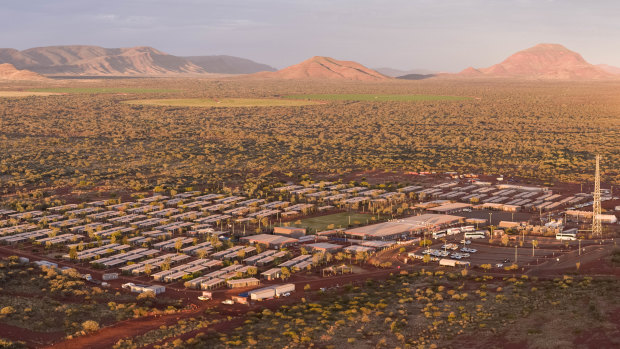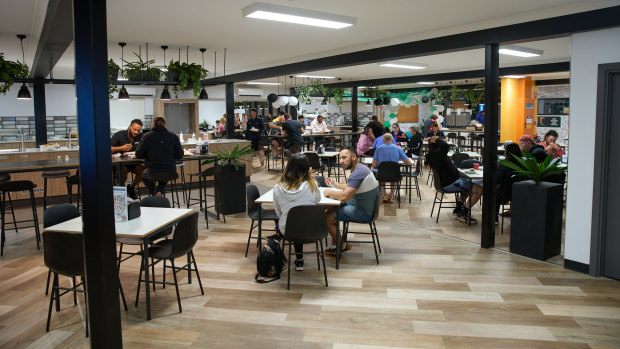By Peter Milne
When Richard Cohen joined Rio Tinto as a graduate engineer 30 years ago, there was only one way to mine iron ore: live in the Pilbara.
It was not until the late 1990s that Rio offered fly-in, fly-out jobs at its new Yandicoogina mine. The swings away from home were long, and amenities fell far short of today’s standards.

The Punurunha village at Rio Tinto’s Marandaroo mine in WA’s Pilbara has more than 900 rooms.Credit: Rio Tinto
“Things were pretty tough. It was very remote. They were in locations where supply chains were challenging … options were limited for flights,” Cohen says. “People spent a lot more time away from family.”
Now Cohen, as managing director of iron ore port, rail and core services, looks after 11,000 employees and contractors who stay in 25 camps on an average day, as well as 4000 workers who live in the Pilbara.
This is largely unprecedented, not only in Rio, but around the globe, and getting it right is vital for attracting and retaining staff in WA’s stretched labour market.
Cohen thinks the most significant change Rio has made in his nearly four years in the role is a mindset change: thinking village communities as investments, not FIFO camps as a cost.
“Now, we’re very clear, it’s such a critical part of the employee experience,” he said.
Cohen gets plenty of positive feedback, but if the food disappoints, rooms are not cleaned well or flights are late, he’ll hear about it – a remote workforce, like an army, marches on its stomach.
Feeding this one is Sodexo, the French giant that in 2016 won a 10-year, $2.5 billion contract to support Rio’s Pilbara operation.
Sheeba Frederick runs a kitchen that feeds 750 to 1000 workers at one village.
She works two weeks on, one off, managing a team of up to 20 chefs, and says that in recent years the main kitchen has changed dramatically.
“We don’t have any stoves and burners any more,” she said. “We work with digitised temperature controls … I control my overnight roasting on my phone.”
In “variable cooking centres” chefs choose what to cook from a screen – a stir-fry or a casserole perhaps – and are guided on what ingredients to add and when.
“Then you close it and then the dish comes out as it is required,” Frederick said.
There is still the conventional approach in a cook-to-order section for workers fancying a steak or grilled chicken, however.
Frederick likes the world of bulk cooking, adding variety with anything from ice sculptures to nights featuring different cuisines.
“Four years ago being a FIFO wouldn’t have been in my mind, but now, I can’t think of anything else,” she said.

A dining hall at Rio Tinto’s Yandicoogina mine in WA’s Pilbara. Credit: Rio Tinto
Richard Cohen took charge of Rio’s villages in the midst of COVID disruptions in 2020 and has since dealt with the fallout of a damning WA parliamentary inquiry into sexual harassment of women working FIFO. Rio’s own report into bullying, sexual harassment and racism in its global workforce was released in 2022.
Both reports called out a power imbalance between company employees and contractors as a contributor to the problems.
“As a long-term Rio employee and a long-term leader those reports were shocking,” Cohen said. “I really had to reflect on what we weren’t seeing and what we needed to do differently.”
He said some changes were basic, like changing daily alcohol limits and improving lighting.
He is also focused on the relationship between Rio and the 2000 Sodexo employees, who not only cook and serve meals but drive buses, clean rooms and maintain buildings.
A small step is co-branding their shirts with both companies’ logos.
Cohen tells the Sodexo workers to never underestimate how important their job is to how well Rio moves iron ore.
“If [the miners] come through the gate with a smile on their face, we are more likely to have a successful day,” he says.
Rio is now trying to boost activities available to off-duty workers, including gym classes, music rooms, places to read, and different spots to eat.
Keeping people safe and healthy in an average year also requires Rio to respond to 50 bushfires, provide 360 hospital transfers and 100 medical evacuations flights, and treat 21,000 patients for various medical complaints.
Progress is being made, with the proportion of women in Rio’s iron ore workforce rising from 19 per cent to 25 per cent in the past five years.
And Cohen says the enormous magnitude of the supply chain brings a lot of complexity: up to 150 semi-trailers a week do a 3000-kilometre round trip from Perth to Rio sites across the Pilbara. Ripples in that supply chain can have significant consequences if not well managed.
In his time, some “ripples” have been more like waves, including COVID border restrictions, floods across the middle of the continent and Qantas pilots striking.
“There’s a lot of people working really hard so that our people and our residents and our villages don’t see it,” Cohen said.
The scale of the operation affects procurement as well as logistics.
Something as seemingly minor as changing the packaging of crib – the lunch workers grab after breakfast before boarding buses to sites – means close communication with suppliers.
“We think it’s a simple change but multiplied by our volume it actually means suppliers often can’t supply and they have to replace their factories or rebase their manufacturing,” Cohen said.
“It actually sometimes means we can’t change as quickly as we would otherwise want to.”
Life for iron ore miners is more comfortable than when Cohen started with Rio, but with long and often blistering hot days, and the separation from home and loved ones, it is still a tougher gig than most jobs.
Unsurprisingly, these hardy workers treat themselves sometimes, and when it comes to chocolate, the favourite buy at Sodexo shops is as Australian as the Pilbara: the Caramello Koala.
Start the day with a summary of the day’s most important and interesting stories, analysis and insights. Sign up for our Morning Edition newsletter.